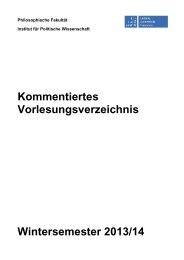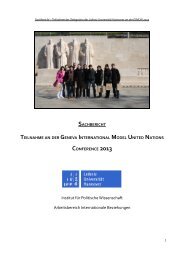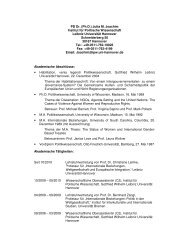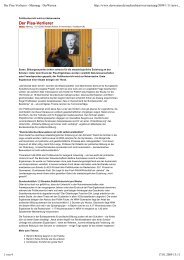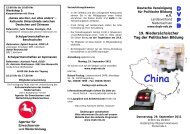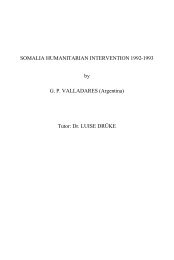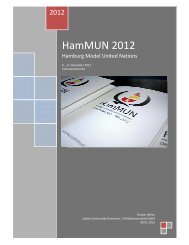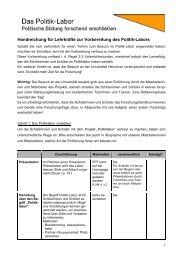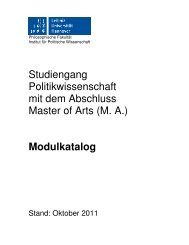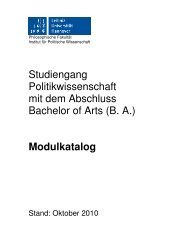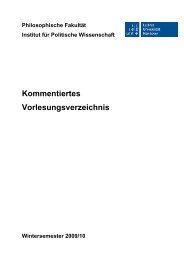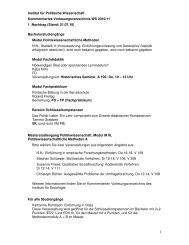Preventive Action for Refugee Producing Situations
Preventive Action for Refugee Producing Situations
Preventive Action for Refugee Producing Situations
Create successful ePaper yourself
Turn your PDF publications into a flip-book with our unique Google optimized e-Paper software.
150 Chapter 4<br />
From the point of view of declaratory prevention value, Security<br />
Council resolutions 687 and 688 (Omnibus resolutions) have been the most<br />
important <strong>for</strong> many years as they embrace the various aspects of the conflict.<br />
There<strong>for</strong>e they may be considered legal precedents as they represent first<br />
steps of the Security Council to <strong>for</strong>mulate a position concerning an internal<br />
situation in a condition of non-war.<br />
Furthermore, in the Report of the Special Committee on the Charter of<br />
the United Nations and on the Strengthening of the Role of the United<br />
Nations (46/58) of 1991, the General Assembly expresses its appreciation to<br />
the Secretary-General <strong>for</strong> the completion of the Handbook on the Peaceful<br />
Settlement of Disputes between States. He is requested to publish and<br />
disseminate widely the Handbook in all the official languages of the United<br />
Nations.<br />
The Declaration on Fact-finding by the United Nations in the field of<br />
the Maintenance of International Peace and Security (46/59) of 1991 gives<br />
the UN Organs an important new basis <strong>for</strong> preventive work. After recalling<br />
previous relevant documents 349 , it outlines in detail the purpose, criteria,<br />
procedures and competencies related to UN Fact-finding activities. It is the<br />
first instrument with such far reaching possibilities and is likely to play a<br />
substantial role in conflict prevention ef<strong>for</strong>ts in the future.<br />
The Cold War-period has impeded the Secretaries-General since the<br />
1960s to be more <strong>for</strong>ceful; its end might allow these declaratory prevention<br />
principles to be invoked more effectively than be<strong>for</strong>e. Another element is<br />
important to add here. The international human rights community,<br />
disarmament agreements and regional conflict resolution work over the past<br />
some 20 years do provide important additional terms of reference <strong>for</strong> the<br />
UN's work in the area of conflict prevention. One thing seems to be clear,<br />
that intentions to do something be<strong>for</strong>e the event is a more accepted concept<br />
in the United Nations and its Member States now. There<strong>for</strong>e, declaratory<br />
prevention has perhaps not been as effective as would be desirable.<br />
However, given the more favorable international<br />
_________________________<br />
on 31 January 1992. United Nations, New York, 1992.<br />
349 Declaration on Principles of International Law concerning Friendly Relations<br />
and Cooperation among States in accordance with the Charter of the UN,<br />
(2625, XXV); the Manila Declaration on the Peaceful Settlement of<br />
International Disputes (37/10); the Declaration on the Enhancement of the<br />
Effectiveness of the Principle of Refraining from the Threat or Use of Force in<br />
International Relations (42/22); the Declaration on the Prevention and<br />
Removal of Disputes and <strong>Situations</strong> Which May Threaten International Peace<br />
and Security and on the Role of the United Nations in this Field (43/51).<br />
New Approaches and Policies 151<br />
political environment today, it is likely to be an integral part in the future<br />
UN work in attempting to prevent conflicts.<br />
One should not <strong>for</strong>get here the declarations in the human rights field,<br />
especially the Universal Declaration on Human Rights of 1948.<br />
2. The Decision-making procedures of the UN <strong>for</strong> conflict prevention:<br />
On the basis of the UN Charter Art. 34, the Security Council may<br />
investigate any dispute.or any situation which might lead to international<br />
friction or give rise to a dispute, in order to determine whether the<br />
continuance of the dispute or situation is likely to endanger the<br />
maintenance of international peace and security. The Security Council<br />
may initiate an action itself or a Member may request action. In cases of<br />
self-initiatation, various Members consult with each other to agree in prior<br />
consultations as to whether or not a particular conflict is to be put on the<br />
agenda. If one Member wishes to bring an item onto the agenda, it<br />
addresses a communication to the President of the Security Council to call<br />
<strong>for</strong> a meeting or, in urgent cases, to call <strong>for</strong> an immediate meeting <strong>for</strong><br />
considering the matter.<br />
Once prior consultations on the conflict among the Members are<br />
completed, and the action to be taken decided upon, a draft text of a<br />
resolution, decision, or statement will be prepared and agreed be<strong>for</strong>e<br />
distribution to the 15 Members in the six official UN working languages<br />
<strong>for</strong> review prior to the <strong>for</strong>mal Security Council meeting. There the text is<br />
officially agreed upon (it becomes a child of 15 parents representing a<br />
consensus of all 15 Members unless there is dissent or a veto, especially<br />
from a permanent Member).<br />
On the basis of Article 35 of the UN Charter, any Member or non-<br />
Member of the United Nations may bring any dispute, or any situation<br />
which might lead to international friction or give rise to a dispute, to the<br />
attention of the Security Council or the General Assembly. In addition,<br />
any Member of the General Assembly may bring an item onto the agenda.<br />
The proposal is first addressed to the General Assembly Committee<br />
composed of the 23 Vice-presidents of the General Assembly and chaired<br />
by the President of the General Assembly, which decides to include the<br />
item in the preliminary agenda of the General Assembly. This in turn<br />
approves the agenda at its first meeting of the session. One of the few<br />
situations in which the General Assembly Committee of the General<br />
Assembly did not approve an item being put on the agenda included a



